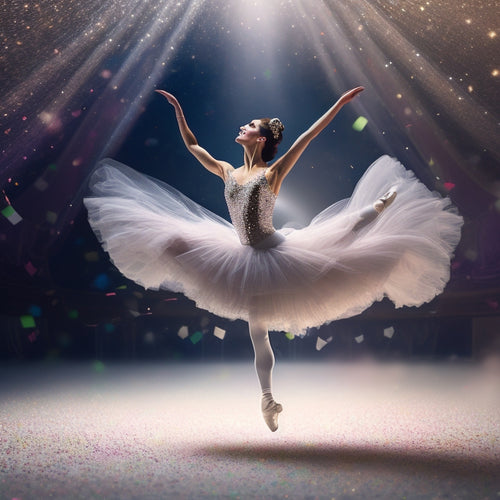
Dance Into Success: Crafting Dynamic CVS
Share
In the competitive dance industry, a dynamic CV is essential for standing out and accessing new opportunities. It showcases a dancer's unique blend of skills, experience, and artistry, setting them apart from the competition. A well-crafted CV highlights technical proficiency, creative expression, and a unique artistic voice, making it a key to success at auditions. By developing a strong performance portfolio and emphasizing unique strengths and styles, dancers can attract attention and pave the way to success. As you take the next step in your dance career, discover the secrets to crafting a CV that truly showcases your artistry and propels you towards success.
Key Takeaways
• A well-crafted CV showcases a dancer's unique blend of skills, experience, and artistry, making a strong first impression on industry professionals.
• A dynamic CV highlights technical proficiency, creative expression, and unique artistic voice, increasing visibility and attracting attention from industry professionals.
• A strong performance portfolio showcases artistic achievements, highlighting performance highlights, training, and special skills, helping directors envision a dancer in their productions.
• Emphasizing unique strengths and styles in a CV helps dancers stand out at auditions, paving the way to success and securing coveted spots in performances.
• A dynamic CV leverages industry connections, opens doors to new opportunities, and propels dancers towards success in the competitive dance industry.
Crafting a Dancer's Dream CV
As a dancer, your CV is often the first impression you make on directors, choreographers, and other industry professionals. It is essential to craft a document that showcases your unique blend of skills, experience, and artistry.
A dancer's CV should be a dynamic representation of their brand, highlighting their strengths and versatility. A visual portfolio can be an excellent addition, providing a glimpse into your performances and style.
Additionally, leveraging industry connections can open doors to new opportunities. By strategically highlighting your skills, experience, and network, you can create a CV that truly stands out.
Showcasing Your Dance Skills
When it comes to showcasing your dance skills, a well-crafted CV is essential for highlighting your technical proficiency, creative expression, and unique artistic voice.
A strong CV is your ticket to standing out at dance auditions and securing coveted spots in performances.
A portfolio presentation that showcases your best work is vital, as it gives a glimpse into your artistic vision and style.
Your dance resume should highlight performance highlights, training, and special skills, making it easy for directors and choreographers to envision you in their productions.
Standing Out in the Dance Industry
To truly stand out in the competitive dance industry, it's not enough to simply possess exceptional technical skill - you must also cultivate a unique artistic identity that sets you apart from the crowd.
Networking opportunities and industry connections are essential in getting your name out there. Develop a strong performance portfolio that showcases your artistic achievements, and don't be afraid to highlight your unique strengths and styles.
By doing so, you'll increase your visibility and attract the attention of directors, choreographers, and other industry professionals. Remember, it's not just about being a great dancer - it's about being a standout artist with a distinct voice and perspective.
Frequently Asked Questions
How Do I Choose a Dance Style to Specialize In?
'Embark on a journey of self-discovery, exploring genres that resonate with your passion and creativity. Identify your strengths, and let your unique style shine, as you enhance your full potential in the art of dance.'
What's the Best Way to Handle Performance Anxiety?
To overcome performance anxiety, dancers can employ breathing exercises to calm the nervous system and mindfulness techniques to focus on the present moment, allowing for a more centered and confident performance.
Can I Still Dance Professionally With an Injury?
"Like a phoenix rising from the ashes, a dancer can still soar despite an injury. Embracing Injury Management and Body Adaptation, you can modify movements, prioritize self-care, and adapt to new circumstances, ensuring your passion for dance remains unbroken."
How Often Should I Take Dance Classes to Improve?
To improve, aim for consistent practice, taking classes 2-3 times a week, focusing on technique and skill-building. As you progress, increase class frequency to 4-5 times a week, honing your craft and refining your artistry.
Do I Need a Dance Degree to Become a Professional Dancer?
Can formal education truly replace the value of real-world experience? While a dance degree can provide a solid foundation, it's often networking, online opportunities, and dedication to craft that truly propel dancers towards professional success.
Related Posts
-

3 Essential Marketing Tips for Dance Makeup Artists
To shine online and attract new clients, you'll need a solid marketing strategy. First, boost your online visibility ...
-

Long-Lasting Dance Makeup: Tips for a Flawless Finish
To achieve a long-lasting dance makeup look, start by preparing your skin through cleansing, moisturizing, and exfoli...
-

Instant Download Card for Dance Recital Performances
Instant download cards are a convenient way to commemorate dance recital performances, providing a seamless solution ...


